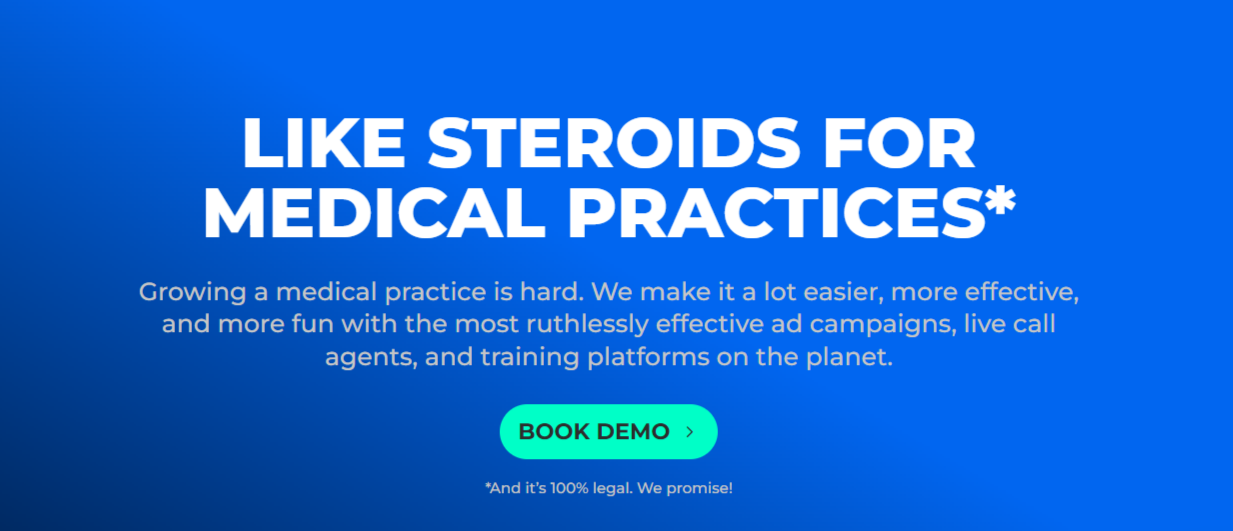Hypothyroidism is a common endocrine disorder that is characterized by an underactive thyroid gland. Millions of individuals all over the globe suffer from this disorder. Knowing how to target and engage patients effectively is important in your pursuit of hypothyroidism marketing. This understanding will allow you to raise awareness, render support and bring about positive health outcomes.
In this blog post, I share the tried and tested strategies that work like magic to reach and assist hypothyroidism patients. When you implement these strategies in your hypothyroidism marketing, you can attract a significant number of patients and help them manage their condition in a better way.
Marketing Guide for Healthcare Practitioners
The American Thyroid Association affirms that approximately 20 million Americans suffer from some form of thyroid disorder. Not only that, but 60% of this population is unaware of their conditions. But, with the increased awareness and advancements in diagnostic technologies, more and more individuals are being diagnosed with hyperthyroidism. This increased awareness gives rise to increased demand for information, support, and treatment options for hypothyroidism patients. The main reason to highlight these facts is that it signifies enough opportunities exist that you can fully exploit through hypothyroidism marketing.
Ready to take your hypothyroidism marketing strategy to the next level? Schedule a discovery call here to learn about our digital marketing services and how we can help you reach and engage your target audience effectively.
Targeting Strategies for Hypothyroidism
As there are ample opportunities, all you need to do is implement targeting strategies so that you can attract these patients and serve them while growing your practice at the same time. By incorporating innovative strategies in your hypothyroidism marketing plan, healthcare marketers can enhance their targeting efforts and provide advanced support to hypothyroidism patients. Below, I am sharing a couple of strategies to target these patients and get a chance to serve them.
Targeted Digital Advertising
The first and the most widely used strategy that can do wonders in hypothyroidism marketing is to run targeted digital advertising. Through these targeted digital ad campaigns, you can reach and attract hypothyroidism patients. You can utilize popular platforms such as Google Ads or social media avenues like Instagram, Facebook, and TikTok to create ads specifically targeted at individuals seeking information related to hypothyroidism or showing relevant interests. You can tailor your messaging to resonate with their specific concerns and highlight the benefits of your services.
The reason why I am emphasizing opting for targeted digital ads is because of their remarkable ability to spot hypothyroidism patients from the sea and bring them right in front of you. We know that hypothyroidism can occur at any age, but it is more common among older individuals. Also, research shows us that 5% of the US population suffers from some sort of thyroid disorder, with women being more susceptible than men.
Through research, it is known that women are five to eight times more likely than men to have thyroid problems. You can add Facebook ads to your hypothyroidism marketing plan to reach this refined audience suffering from hypothyroidism. One of the most impressive features of Facebook advertising is its accurate targeting capabilities. You can use Facebook’s detailed demographic and interest-based targeting capabilities to narrow down your audience and target women or older individuals. When you cannot find enough older population to target, you can consider reaching out to individuals who have shown interest in thyroid health, endocrinology or other related topics.
Then, you can also lean heavily on Google Ads, which guarantees remarkable results and is known for producing such. This digital medium of advertising is great when targeting a specific audience through keywords. For instance, if you want to use Hashimoto’s thyroiditis, which is the most common cause of hypothyroidism in the United States, then Google Ads is the best option for you.
Google Ads is a platform with extraordinary targeting capabilities for your digital advertising. By incorporating relevant keywords related to hypothyroidism, such as “hypothyroidism treatment,” “underactive thyroid,” or “Hashimoto thyroiditis,” you can create text ads that appear in search engine results when individuals actively seek information about the condition.
Also, read: Targeting Your Chiropractic Marketing: Who is Your Ideal Patient?

Search Engine Optimization for Hypothyroidism Marketing
While I am talking about keywords, it brings me to another potent source to target hypothyroidism patients. And that source is opting for search engine optimization in your hypothyroidism marketing.
What happens in SEO is you optimize your website and all sorts of digital content for relevant keywords related to hypothyroidism. For that, you have to conduct extensive keyword research to become acquainted with search terms that are commonly used and incorporate them in your hypothyroidism marketing materials.
This results in improving your ranking in search engine results, increasing visibility, and attracting motivated hypothyroidism patients. Keyword research and incorporation is just one strategy to target hypothyroidism patients; however, you can also put into practice other SEO-related strategies to better impact the results. Let me briefly share these different SEO-related strategies here so that you have an idea about how you can improvise your SEO strategy and derive results.
While you search for keywords and incorporate them into your content, you also have to make sure that the content you produce and publish must be of supreme quality and provide valuable information to readers and visitors.
You can write high-quality blog posts, guides, and even FAQs related to hypothyroidism symptoms, causes, treatments and lifestyle recommendations. By consistently publishing valuable information, you not only develop authority in the eyes of visitors, but you also make search engines believe that you are a credible source.
Another great strategy is optimized meta tags. You must optimize your meta tags, including meta title and description for each page of your website and blog posts. Aim to incorporate relevant keywords in these tags naturally while ensuring that they accurately describe and complement the content of the page. Well-optimized meta tags are one of the crucial aspects of improving your search engine visibility that many do not consider important.
Internal and external linking is another smart strategy to improve your SEO efforts. You can internally link your pages to render a logical ad easy-to-navigate structure. This helps search engines understand the connection, hierarchy, and relevance of your content. For external linking, you can look for opportunities to acquire backlinks from well-known and reputable websites in the healthcare and thyroid health space. These backlinks from authoritative and reputable sources signal to search engines that your content is valuable and trustworthy, which in turn boosts your search ranking and visibility.
While implementing these SEO strategies, you can tailor them to target your specific hypothyroidism patients. By doing so, you can improve your organic traffic and website’s visibility. The key to success is to keep monitoring the performance of your website, tracking keyword rankings, and adjusting your strategy accordingly.

Influencer Partnership
Influencer partnership is a quintessential part of modern marketing and must be included in your hypothyroidism marketing plan. Influencer marketing works well in all phases, but it can generate the most impressive results when targeting specific groups. Meaning, you can safely opt for this strategy to target hypothyroidism patients.
Collaborating with influencers or patient advocates in the hypothyroidism space can be a good idea. For this, you have to identify individuals who maintain a good reputation and strong presence on social media or run a blog related to thyroid health. Don’t only look for people who run a blog related to thyroid health aspects, You can also consider any blogger in any niche that has issues with their thyroid health and often mentions it on their platforms. You can partner up with them to raise awareness or to spread the word about your services or treatments.
These bloggers and influencers can play a vital role in spreading your message to a wider audience of hypothyroidism patients who trust their recommendations.
Moreover, you can also choose to co-create content with these bloggers. This ensures that you are promoting content that resonates with their audience as well as aligns with your hypothyroidism marketing goals. This co-creation of content can take different forms, such as live Q&A sessions, sponsored blog posts, videos, and other social media campaigns. Co-created content adds credibility to your brand and leverages the influencer’s authenticity and expertise.
Also, read: 5 Proven Tips for Attracting More Patients to Your Neuropathy Practice

Personalized Email Campaigns
Another strategy that can bring remarkable results to target hypothyroidism patients is to implement personalized email campaigns.
The systematic way to practice this strategy is to segment your email list and then deliver targeted content, stories, guides, and tips that resonate with the unique needs of each segment. Research shows that emails with personalized subject lines generate a 50% higher open rate. This signifies that personalization encourages engagement and cultivates a stronger connection, pushing patients to take action or seek further support.
In addition to segmenting your email list, you can also opt for triggered emails based on specific events or actions. For instance, you can send a welcome email to a new patient or you can send out follow-up emails after appointments. Triggered emails work wonders and nurture patient-provider relationships.
While you work on personalized email campaigns as an integral part of your hypothyroidism marketing plan, you must also not forget to add clear and compelling CTAs. A clear and strong CTA encourages the recipient to take action, such as scheduling an appointment, signing up for a webinar, downloading a resource, or participating in a survey.
In order to improve the effectiveness of your email campaigns, you must optimize them regularly. This means testing out different subject lines, opting for different layouts, and adding new CTAs to identify what yields the best results. Not only that, but you can also gain insight into recipient preferences and behaviors by analyzing open rates, click-through rates, and conversion rates. You can then use this data to refine your email content and strategy.

Final Thoughts
As a hypothyroidism marketing personnel, you need to embrace a comprehensive approach to target and support hypothyroidism patients. By utilizing valuable informational content, running targeted digital advertising, and optimizing SEO techniques, you can reach and assist individuals living with hypothyroidism. Adopt these above-mentioned targeted strategies to positively impact the lives of hypothyroidism patients.
Schedule a call with our digital marketing experts to explore tailored strategies and solutions that will maximize your online presence, attract more patients, and drive better results. Don’t wait; book your call today by clicking here!
Eager to gain more valuable insights into various aspects of digital marketing? Check out my other blog posts.
- 5 Effective Strategies To Boost Your Functional Medicine Practice Online
- The Future of Functional Medicine Marketing: Embracing Digital Transformation
- The Art of Neuropathy Patient Acquisition: A Step-by-Step Guide
FAQs
Q1: What are the best practices for creating compelling ad content that resonates with hypothyroidism patients?
A: There are several factors that you need to consider while creating compelling, targeted ads. In addition to selecting a well-defined segment, you need to ensure that your ad has captivating copy, complimenting imagery, and meets all advertisement rules and regulations of the platform you are using.
Q2: How can I measure the effectiveness and ROI of my targeted advertising campaigns in attracting hypothyroidism patients?
A: There are many tools and resources through which you can measure how your hypothyroidism marketing ads are performing. Various platforms have their own analytical tools that give you real-time updates about conversions.
Q3: How often should I send personalized emails to hypothyroidism patients without overwhelming them?
A: The frequency of sending personalized emails should strike a balance between staying engaged and providing valuable content without overwhelming their inboxes. While there is no one-size-fits-all answer, a general guideline is to aim for a consistent and regular cadence that respects the patient’s preferences.
Q4: How long does it typically take to see results from SEO efforts in the context of hypothyroidism marketing?
A: The timeframe for seeing results from SEO efforts in hypothyroidism marketing can vary, but it generally takes several months to start seeing noticeable improvements in search engine rankings and organic traffic.

Zack Siegel
Founder/CEO
Zack is a conversion rate lover and PPC ad man spending most of his time optimizing.
He’s an avid bookworm, Chipotle’s most valued customer, and pursuant stand-up comedian…
We give him reality checks every day.


